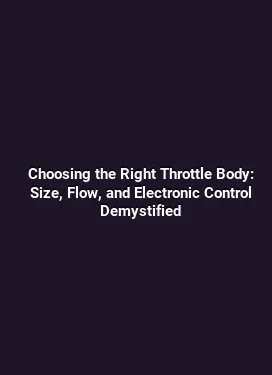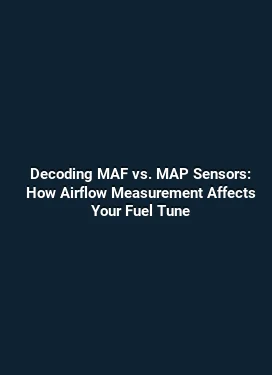Side-by-Side: The Best High-Flow Air Filters for Filtration and Performance Upgrades
High-flow air filters have become a cornerstone in modern intake and fuel system upgrades. The goal is clear: maximize air throughput to the engine while maintaining reliable filtration and enduring longevity. When choosing a filter, the balance between airflow and filtration efficiency, maintenance intervals, and compatibility with the vehicle’s intake tract matters as much as raw numbers on a spec sheet. This guide dives into the practical realities of high-flow designs, how they interact with different intake configurations, and how to select a filter that delivers measurable, real-world gains without compromising protection or reliability.
Understanding High-Flow Air Filters and Their Role in Intake Systems

High-flow air filters are engineered to reduce flow resistance compared to stock solutions, particularly at the engine’s higher intake velocities. Their design prioritizes a larger surface area, optimized pleat geometry, and materials that favor minimal pressure drop while preserving particulate filtration. The intake system, from the air box to the throttle body, acts as a path with varying resistance. A well-chosen high-flow filter lowers overall pressure drop across the system, which can translate to improved throttle response and a more consistent air supply during wide-open throttle and high-load driving conditions.
Airflow is only part of the equation. Filtration efficiency remains essential, especially in environments with dust, pollen, or urban pollutants. Premium high-flow filters employ media that capture fine particles without becoming clogged quickly. The trade-off between filtration performance and airflow is a practical concern; some designs excel in clean air conditions but lose performance in dusty environments. The key is selecting a filter whose filtration media and pleat structure deliver solid protection while not introducing unnecessary drag in the intake tract.
Vehicle dynamics respond to seemingly small changes in air delivery. A filter that reduces restriction at the element level can contribute to modest yet meaningful gains in torque delivery and horsepower, particularly at mid to high RPM ranges where the engine breathes harder. For many enthusiasts, the objective is a balanced package: a filter that keeps debris out, maintains consistent performance across weather and altitude changes, and supports a stable air-fuel mixture when paired with appropriate calibration or driving conditions.
Top Factors to Consider When Assessing High-Flow Filters
Choosing among high-flow options requires looking beyond advertised airflow numbers. Practical considerations include media type, sealing method, fitment, cleaning or replacement intervals, and compatibility with the vehicle’s throttle body and intake tubing. Oil-coated versus dry media is a frequent topic in this space. Oil-free or dry media can offer faster and easier maintenance, while oiled media sometimes provides robust filtration at the risk of attracting dust to adjacent surfaces if not properly maintained.
Fitment accuracy is crucial. A filter that seals well within the housing minimizes unfiltered air bypass. Some designs include replaceable end caps or modular assemblies to suit a range of vehicle applications. In certain setups, a slightly larger filter with a redesigned housing can deliver noticeable gains by increasing surface area and reducing local flow turbulence. However, oversized options may require trimming the intake box, sensor relocation, or hose modifications, so a careful compatibility check is essential before purchase.
Maintenance frequency is another practical consideration. High-flow filters with larger surface areas often need less frequent cleanings than factory units, but the cleaning methodology can differ. Following the manufacturer’s cleaning intervals and approved cleaning agents preserves the filter’s integrity and performance. If a filter relies on oil, ensuring even oil distribution without over-saturation is critical to avoiding elevated intake particle carryover or sticky buildup on sensors and throttle bodies.
Top Candidates for Intake & Fuel System Upgrades
Across the market, several high-flow air filters stand out for their balance of filtration, airflow, and broad vehicle compatibility. The best choices offer predictable performance gains without compromising long-term durability. When evaluating options, consider your driving style, climate, and whether the vehicle’s ECU or engine management will respond positively to improved air delivery. Documentation that includes real-world dyno data or track testing, even if not official, can provide practical confidence beyond catalog claims.
Oil-Coated High-Flow Filters: Balanced Filtration and Flow

Oil-coated options use a gauze or mesh media saturated with a light oil to trap particles while maintaining high air throughput. This approach tends to maintain filtration efficiency across a broader spectrum of particulates. The trade-off is the potential for oil carryover if the filter is over-oiled or installed improperly. In performance-oriented builds, oil-coated designs often yield steady gains in mid-range torque and improved throttle response, especially when paired with a compatible intake tube that minimizes bends and turbulence. Regular inspection of the filter’s oil level and a careful cleaning regimen help sustain benefits without introducing intake contamination.
Dry-Filter High-Flow Solutions: Simplicity and Quick Maintenance
Dry media filters prioritize ease of maintenance and faster service intervals. They typically require less risk of residue buildup on sensors and intake components. Modern dry media can deliver competitive flow numbers while keeping filtration efficiency high enough for most street driving scenarios. The practical advantage is straightforward: quicker cleaning cycles, lower risk of oil-related issues, and reliable performance in varying weather. For racers or street enthusiasts who swap performance parts frequently, dry filters offer a convenient balance of performance with minimal maintenance overhead.
Performance Mesh and Pleated Designs: Surface Area Maximization
Filters with advanced pleat geometries or mesh matrices aim to maximize surface area within a compact footprint. By spreading the flow over a larger area, these designs reduce localized restrictions and support consistent air delivery across a wider range of operating conditions. Expect smoother throttle response, especially at higher RPMs, and a more linear feel when under load. The increased surface area often correlates with longer service intervals, though inspection and cleaning remain essential to prevent performance degradation from debris buildup.
Seal Integrity and Housing Fitment: The Hidden Advantage
Beyond the media itself, seal quality and housing compatibility can determine real-world performance. A high-flow filter that fits perfectly with the factory air box or a refined aftermarket intake duct minimizes air bypass. Some systems use gasketed seals or clip-in retention features to ensure a consistent seal under vibration and temperature cycling. This practical detail translates to more predictable airflow and better overall system responsiveness, particularly in off-idle scenarios where a small amount of unfiltered air can impact fuel delivery and combustion stability.
Installation Considerations and Practical Tips
Installing a high-flow filter is not merely snapping a new element into an air box. A thoughtful approach includes verifying sensor positions, ensuring hose clamps are snug without over-tightening, and confirming there are no kinks or sharp bends in the intake tubing that could negate the gains from a higher-flow filter. When upgrading in a fuel-injected setup, check that the air-fuel ratio remains stable under load and during sudden throttle inputs. If your vehicle uses a mass air flow sensor, ensure the sensor wires and connections are not obstructed by the new intake geometry. In some cases, a brief ECU adaptation period or a tune adjustment can help the engine harmonize with the augmented air supply, particularly in tune-heavy or highly modified builds.
Maintenance remains the backbone of sustained performance. Dry media typically requires regular inspections, especially after dusty drives, while oil-coated designs demand careful oiling practices and periodic re-oiling to maintain filtration efficacy. A simple schedule—inspect after every long trip, clean as recommended, and replace within the manufacturer’s window—helps maintain consistent airflow and protection. When removing and re-installing components, avoid bending the intake tube, which can create micro-turbulence that offsets the benefits of the filter upgrade.
Quality Checks During Reassembly
After installation, perform a diagnostic check for sensor readings and air intake temperatures. A small discrepancy in MAF signals or a slight flutter in the intake can indicate a misfit or a leak. A quick smoke test or a simple vacuum test can reveal unsealed joints. If a leak is found, reseat the filter and re-torque clamps to manufacturer-specified levels. The goal is a quiet, smooth intake path with stable readings across driving conditions.
Beyond the Filter: Complementary Upgrades for Maximum Benefit
Upgrading the filter is often most effective when paired with complementary components that reduce intake resistance. A well-matched cold-air intake or a larger-diameter piping upgrade can further improve flow characteristics. It is important to ensure the additional air path does not introduce turbulence or an increase in piping length that delays air arrival. Couple these upgrades with a high-quality air-fuel management strategy to avoid leaning out the mixture during hard acceleration. For naturally aspirated engines, the gains may be more incremental, but in turbocharged or supercharged platforms, every incremental improvement in air delivery can translate to meaningful power and torque enhancements, especially at higher RPM bands.
Monitoring tools such as air velocity measurements within the intake tract, intake manifold pressure, and real-time fuel trims provide practical insight into how changes affect engine behavior. A staged approach—start with a filter upgrade, then add tubing or a larger intake box, followed by calibration adjustments—helps gauge each modification’s impact without overcomplicating the system. Real-world testing under varied driving conditions, including highway cruising, sustained climbs, and cold-start scenarios, provides a robust picture of performance and reliability across the installation’s lifetime.
Choosing the Right Filter for Your Vehicle
Vehicle-specific factors play a decisive role. A compact commuter with a relatively low air demand benefits from lightweight, easy-to-maintain options, whereas a performance-oriented build with a high RPM ceiling may justify more aggressive high-flow designs focused on maximizing surface area and minimizing restriction. Climate and typical driving environments influence maintenance expectations: dusty regions hasten filter soiling, while clean, dry climates may allow longer service intervals for certain dry-media configurations. The best choice aligns with the vehicle’s intake geometry, sensor compatibility, and the owner’s tolerance for maintenance frequency versus perceived performance gains.
When selecting among top options, consider a track record of reliability under real-world usage, the ease of sourcing replacement media, and how the filter integrates with other upgrades already installed. A well-chosen high-flow filter becomes not just a single upgrade but part of a coherent intake strategy that preserves filtration integrity while delivering tangible, repeatable performance improvements during sustained driving sessions.
Long-Term Durability and Practicality
Durability matters as much as initial performance. The filter’s media should resist deterioration from temperature fluctuations, vibration, and the occasional water exposure in wet climates. A robust clamp system and solid sealing surfaces help preserve a consistent seal and airflow. A filter designed with modular elements or easy-to-replace components reduces downtime during maintenance, facilitating more reliable ownership and enjoyment of the upgrade over the vehicle’s lifespan.
Implementation Roadmap for Enthusiasts
Begin with a precise assessment of your current intake path: diameter, bends, box volume, and sensor positioning. Identify a high-flow filter that matches your air box footprint or offers a simple adapter kit to minimize modifications. Plan maintenance cycles based on your typical driving conditions, and keep a log of air-fuel behavior under different operating modes. Finally, pair the upgrade with a calibrated driving strategy—whether a minor ECU recalibration, a piggyback controller, or a tune from a trusted tuner—to harmonize the air supply with fuel delivery and ignition timing. This modular approach ensures the upgrade contributes meaningful, repeatable improvements without compromising reliability.
In summary, the most successful high-flow air filter upgrades strike a balance between increased airflow, robust filtration, straightforward installation, and practical maintenance. By focusing on fitment, media quality, and compatibility with the broader intake system, enthusiasts can achieve noticeable improvements in throttle response, mid-range torque, and overall driveability without sacrificing engine protection or long-term durability.






